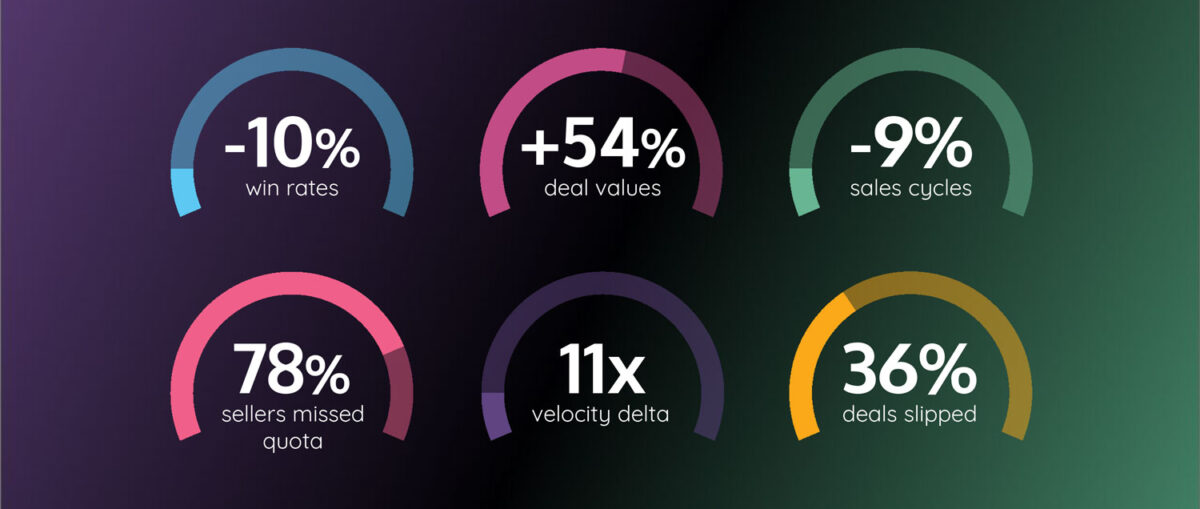
The State of GTM in 2025: What’s Changing in Sales?
Go-to-market (GTM) strategies are evolving rapidly in 2025; the latest trends reveal a shift toward AI-powered efficiency, stronger sales and marketing alignment, and a widening performance gap between top and bottom sellers.
As businesses refine their sales approaches, some key metrics show improvement, while others highlight ongoing challenges. This article breaks down the latest insights and provides actionable strategies for revenue leaders to stay ahead.
Key GTM Metrics: A Mixed Picture
Our analysis of $48 billion opportunities and a survey of 2,000 CROs reveals that sales teams are seeing both progress and setbacks:
- Win rates have improved from -18% in 2024 to -10% in 2025
- Deal values are up +54% year-over-year
- Sales cycles are 9% shorter, reversing a 16% increase in 2024
- 78% of sellers missed quota in 2025, up from 69% in 2024
- Seller velocity delta has grown to 11x, meaning top sellers are closing deals much faster than lower performers
- Deals slipping past their close date have dropped from 44% in 2024 to 36% in 2025

The Growing Performance Gap Between Sellers
As businesses ramp up hiring post-2024, the performance gap between top and bottom sellers is widening. Just 14% of sellers drive 80% of revenue, highlighting an 11x difference in seller velocity – a sharp increase from 8.9x in 2024.
“The gap between top and bottom performers has never been wider,” says Mark Ma, Data Scientist at Ebsta. “Organizations need to analyze their top sellers’ behaviors, double down on what works, and provide the necessary coaching and technology to elevate underperformers. Without this, the gap will continue to grow, putting more pressure on elite sellers.”
This disparity is not just about skill. Data shows that top performers are leveraging technology, especially AI, to optimize their workflows.
The Role of AI in Sales Optimization
Artificial intelligence (AI) is now a must-have for sales teams, helping to:
- Prioritize high-value accounts
- Automate repetitive tasks
- Analyze seller performance trends
- Refine Ideal Customer Profiles (ICP)
- Provide real-time deal insights
“AI isn’t just a tool anymore – it’s a necessity,” says Ma. “Sales teams that harness AI-driven insights to enhance their prospecting, engagement, and follow-ups are seeing remarkable efficiency gains. The data shows that AI-driven teams are outperforming traditional sales teams by a significant margin.”
What’s Driving Success for Top Sellers?
Elite sellers close more deals faster and focus on high-value opportunities by leveraging AI-driven insights. The key differentiators include:
- Data-driven decision-making: Using predictive analytics to prioritize leads
- Automated follow-ups: AI-assisted outreach to maintain engagement
- Pipeline discipline: Identifying deals likely to close and reallocating effort accordingly
The GTM playbook is shifting, and businesses that replicate top-performing strategies will outperform competitors. Those who don’t will struggle to keep up.
Actionable Strategies for CROs and GTM Leaders
To stay ahead in 2025, Chief Revenue Officers (CROs) and sales leaders must implement AI-driven efficiency strategies and optimize their go-to-market execution.
1. Leverage AI for Smarter Sales Execution
Leverage AI for smarter sales execution by implementing AI-powered forecasting tools that enhance deal predictability. These tools analyze historical data and market trends to provide more accurate sales forecasts, helping teams make informed decisions.
Additionally, AI-driven lead scoring enables sales teams to prioritize high-converting accounts, ensuring that efforts are directed toward the most promising opportunities.
Automation further enhances productivity by handling routine tasks such as follow-ups and reminders. By automating these processes, sales teams can focus on building relationships and closing deals rather than spending time on administrative work. This not only increases efficiency but also improves overall sales performance.
2. Close the Seller Performance Gap
Close the seller performance gap by implementing mentorship programs where top sellers guide newer reps. Experienced sales professionals can share best practices, strategies, and insights to help newer team members ramp up faster and improve their skills.
This peer-to-peer learning approach fosters collaboration and ensures that knowledge is consistently passed down, strengthening the overall sales team.
In addition to mentorship, investing in data-driven coaching tools can provide real-time feedback and personalized development plans. These tools analyze performance metrics to identify areas for improvement, allowing managers to offer targeted coaching.
Adjusting incentives to reward deal quality over volume further ensures that sellers focus on meaningful, high-value deals rather than chasing sheer numbers, ultimately driving better business outcomes.
3. Strengthen Sales and Marketing Alignment
Strengthening sales and marketing alignment starts with implementing shared performance dashboards to track the conversion of marketing-qualified leads (MQLs) to sales-qualified leads (SQLs). These dashboards provide both teams with real-time visibility into lead progress, ensuring better collaboration and accountability.
By aligning on key metrics, sales and marketing can work together more effectively to refine strategies and optimize lead nurturing efforts.
Another crucial step is adopting account-based marketing (ABM) strategies to target high-value deals. ABM ensures that marketing and sales efforts are concentrated on the most promising accounts, leading to higher conversion rates and better resource utilization.
Additionally, improving the ideal customer profile (ICP) definition helps both teams focus their efforts on the right prospects, increasing efficiency and driving better results.
4. Reduce Deal Slippage
Reducing deal slippage starts with improving sales forecasting accuracy to minimize last-minute delays. By leveraging AI-driven forecasting tools and historical data analysis, sales teams can better predict deal timelines and identify potential risks early.
This allows them to proactively address obstacles and set more realistic expectations, reducing the chances of deals getting pushed to the next quarter.
Another key factor is enhancing deal qualification to filter out low-likelihood opportunities. By using structured qualification frameworks and data-driven insights, sellers can focus their efforts on deals with the highest chances of closing.
Equipping sellers with real-time analytics further empowers them to track deal progress, identify bottlenecks, and take timely action to keep deals moving forward.
Summary: The Future of GTM in 2025
GTM in 2025 is changing and sales teams that adapt to these shifts will thrive. Businesses that invest in AI-driven strategies, sales enablement, and stronger alignment between GTM teams will be best positioned for long-term success.
The momentum is here. Now it’s about taking the right steps to capitalize on it.
 |
Get Your GTM Score |
|---|---|
Will you get 100%, 47% or something lower? Take 3 minutes to answer 10 questions and get a percentage score plus AI-generated advice about your GTM performance. www.ebsta.com/gtmscore |
|
Table of Contents
Share this article
Sign up for Insights
Learn from the brightest minds how to predictably and efficiently grow revenue.
Related Content
Why 52% of New Revenue Now Comes From Existing Customers
In this episode of Revenue Insights, host Guy Rubin sits down with Ben O’Mathuin, Principal Consultant at Customer Lift, to explore how companies can transform Customer Success (CS) from a retention function into a strategic revenue driver. Discover why traditional QBRs are becoming obsolete, how to create meaningful C-suite engagement, and the practical frameworks for…
The Essential Sales Tech Stack for Startups (Without the Bloat)
A sales tech stack is the collection of tools your sales team uses every day to generate pipeline, connect with prospects, and close deals.
Ebsta and Fullcast: Better Together
In 2021, Gartner research predicted that 75 percent of companies would be using a RevOps model by the end of 2025. Revenue operations is arguably the most talked-about topic in recent months. However, it still feels like the revenue engine powering most go-to-market teams today is running on fumes, and no one’s admitting it. Misaligned…


